

 The Accurate Reloading Forums
The Accurate Reloading Forums  THE ACCURATE RELOADING.COM FORUMS
THE ACCURATE RELOADING.COM FORUMS  Guns, Politics, Gunsmithing & Reloading
Guns, Politics, Gunsmithing & Reloading  Gunsmithing
Gunsmithing  Spiralock threading for barrels
Spiralock threading for barrelsGo  | New  | Find  | Notify  | Tools  | Reply  |  |
| one of us |
Harold Vaughn, in his book, described a threading technique that is supposed to give a more uniform thread load at the barrel to receiver joint, and inhibit the possibility of motion there. I contacted the company that makes Spiralock and they make there tools for the female thread. Has anyone used this technique for male barrel threading? Was it beneficial? Do you have the dimensions for making this threading tool for a lathe? | ||
|
| one of us |
| |||
|
| one of us |
I started using the Spiralock thread form about two years ago. http://www.spiralock.com/ This form was designed for female threads. However since most rifle actions lack wall thickness for new threads Greg Tannel convinced them to make an insert for doing male threads on barrel. Not cheap. $200 for a single insert !! Very careful not to jam this. On a previous thread I indicated that whule I have no numbers to make any enhanced accuracy claims, one can surely tell the difference screwing barrel into receiver. One problem I have experienced is NOT to cut a very tight Class 3 thread. Hardened receiver threads will destroy barrel threads and certainly is not necessary. Wally | |||
|
| one of us |
I really should reread Vaughns book before asking this question. As I recall it seemed to me that you could grind a tool to turn the male threads on a lathe. In fact I was thinking of trying it. My question; Why wont this work?. Thanks! | |||
|
| one of us |
quote:There is a patent on the thread form. Wally | |||
|
| one of us |
Vaughn was told that gunsmiths were free to use the thread. That has nothing to do with turning the thread on a lathe. Take Care! | |||
|
| one of us |
quote:If that is the case I see no problem grinding this profile. Sure would take the pucker factor out of jamming a $200 insert. Does Vaughn have a Spiralock source for this claim? | |||
|
| one of us |
It is covered in his book "Rifle Accuracy Facts". Good luck! | |||
|
| one of us |
About 10 years ago, I did a Finite Element study of the benifits of the Spiralock thread form compared to the standare 60 degree thread. The analysis was done on a 10-32 thread, but larger threads should show similar results. I need to make a view of the thread while being loaded, but I have the plots showing the thread load distribution: 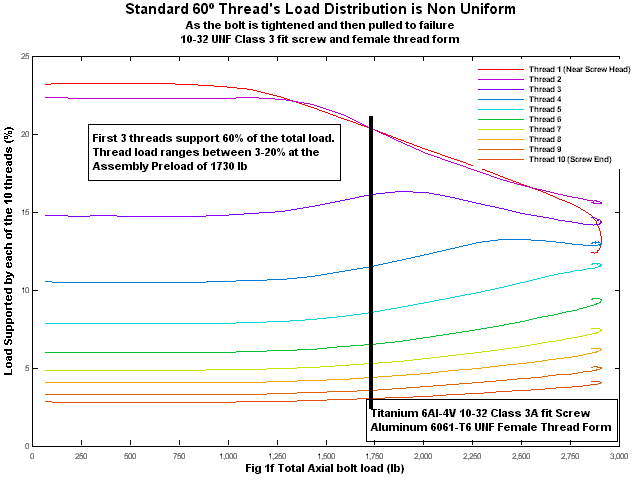 Standard 60 degree thread form with the first three threads taking most of the load. 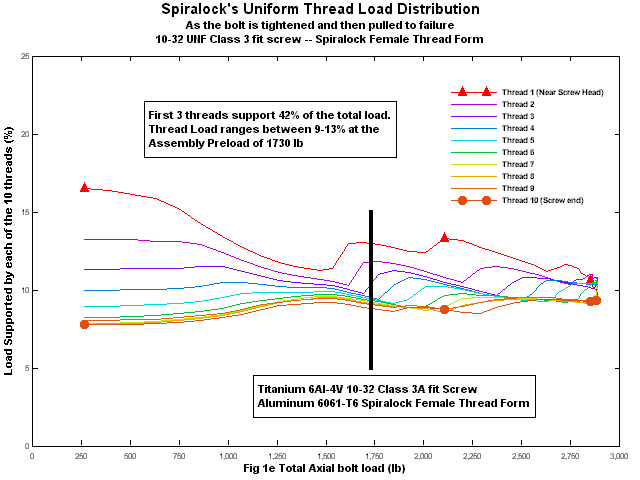 Spiralock thread form. Much more uniform thread load all the way to the last thread. Another aspect is the radial load. A side load on a standard 60 degree thread is not supported as well as with the Spiralock thread form. This would better anchor a barrel in the action for lateral stiffness. I need to find the plots of radial load. When I find them, I will post them here. Good Hunting... from Varmint Al | |||
|
| one of us |
Probably more important are the radial loads on the threads. I found the two plots comparing the radial loading between the Spiralock and Standard 60 degree threads: 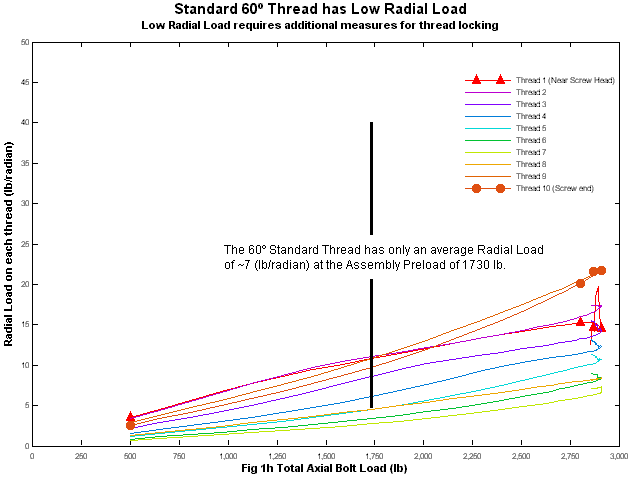 The radial loading resists the side loads as the barrel wants to bend. 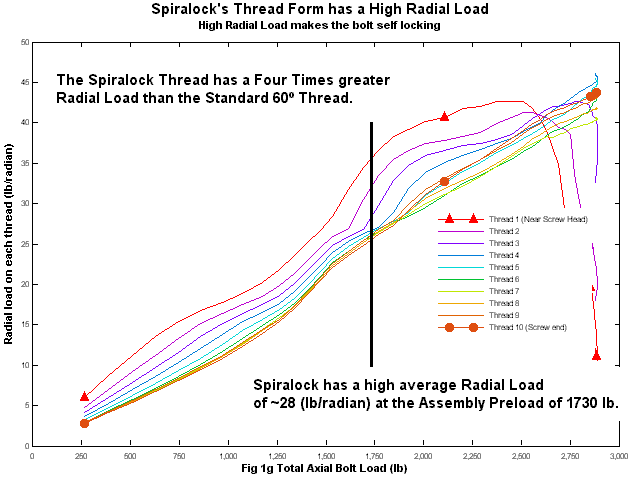 Good Hunting... from Varmint Al | |||
|
| one of us |
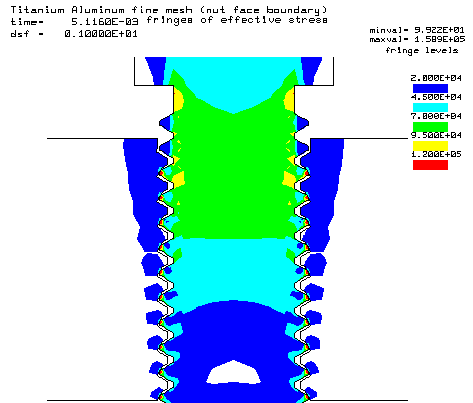 This is a view of the Finite Element calculation at the 1730 lb assembly load. Note that there is yielding even down to the #10 (last) thread. The local yielding at the tip of the male thread allows the more uniform load distribution. 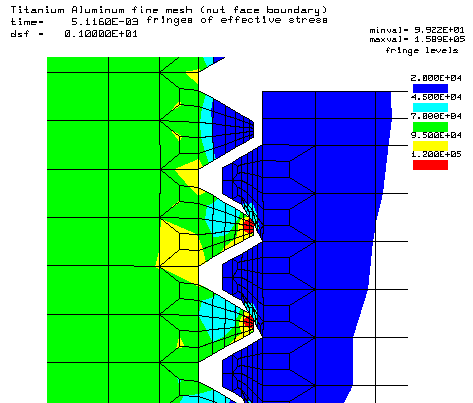 Here is a close-up of the first 2 threads. It shows the local yielding at the thread tips. The shallow angle at the base of the female thread gives the high radial force. The high radial force is the secret to the Spiralock thread form's locking feature. Good Hunting... from Varmint Al | |||
|
| one of us |
The first thing everyone has to understand is that the Spiralock system was designed as just that- A locking system for nuts. It accomplishes this locking by thread deformation. When it comes to the mating of a barrel to a receiver, the forming of a Spiralock type thread on the barrel shank is primarily a means of compensating for a poor thread fit. In order for the thread to work as designed, some deformation must take place. If you are fitting a stainless barrel to a stainless action you are begging for the threads to gall. Probably the best system for lateral stability is a very well fitted square thread. When I build target rifles on Enfield or Springfield actions ( and I still occasionally do so)I fit the barrel with "zero" tolerance and lap them together. There is no lateral movement in this case. To improve loading of the threads it might be best if the male thread were made with a very slightly shallower pitch than the female thread. In the end it's not likely that it makes a lot of difference one way or the other. A whole bunch of BR rifles are shooting aggregates under .2moa using conventional threads and not installed very tightly either. I would have to think that lateral stability can't be all that bad. I personally would not cut a thread of this type on the barrel unless the receiver featured the same thread in female form and the two could be fitted precisely. Otherwise the system is much akin to mating a "V" female thread with a male Acme form. I don't think much of it and don't much care if Harold Vaughn thinks it's great! Regards, Bill | |||
|
one of us |
As a mere observation, it would appear that the Spriralock thread is reducing the amount of surface area contact, which is why it would probably assemble more smoothly on the average. It is also for this reason that it is causing a distortion of the mail threads. This would account for the radial load that is being more evenly distributed along more of the threads, rather than the first three or so of a 60deg. conventional thread. I would be skeptical as to whether this would provide anymore shear strength than a conventional thread. In fact, I would presume that it would be probably less. But, with all of that aside, I fail to see in real benefit in the use of them, other than to amuse a customer or two. In the event of failure of the receiver, the barrel threads will be the last to be affected. Bolt setback and or receiver ring rupture will be the result, and you'll find that the barrel threads, whether they be spriraled, conventional, or squared, will be the last to fail in the system. I think I'll stick to the standard threads with square shoulders and inexpensive inserts. | |||
|
| Moderator |
i thought i posted on this thread... 1: this aint new new new new.. but it is a new WAY of doing it.. 2: the germans discovered that only the last couple threads had any load on them, 3: they began cutting a taper thread to cause the "front" threads to also bear 4: this is accomplished with square threads in the enfield/prinfield line. square threads bear more load than v thread... it's a fact... 5: the deformation, under "crush" fitting of this WOULD cause galling... no doubt about it. other than that, nice idea... jeffe | |||
|
| one of us |
I'm not an expert but if I built guns for others I would be hesitant to deviate from standard practice just due to product liability. In the diving business there were always plaintiff's attorneys just looking for any procedural deviation to hang their hat upon. I'm sure it's no different with gun suit chasers. | |||
|
| one of us |
These plots were excerpts from a study that was done for a project at the Lawrence Livermore National Lab that need a strong and self locking thread form. Since I save just about everything on my computer or Tapes and CD's now, it was easy to recover them. I am not a gunsmith. I posted the Finite Element Analysis info to help in understanding what the features of the Spiralock threads were and how they worked. I am not necessarily recommending Spiralock thread forms for rifle barrels. Spiralock threads would provide more resistance to bending loads. But stainless steel on stainless steel could give a galling problem unless lubrication was used. As for torque, to achieve the same preload force, the Spiralock threads require about 10% more torque over the standard 60 degree threads. Below is a fine mesh for a 10-32 Grade-3 cap screw of 304 Stainless Steel threaded into 6061-T6 aluminum, 10 threads deep. I ran a test calculation on both the standard thread form and the Spiralock thread form to verify that the mesh is correct. Below is an example state of stress in the aluminum at the 1133 lb assembly preload that loads the bolt to 66.7% of the yield stress. The calculation clearly shows that each thread is loaded in the Spiralock thread and that only the first few threads are supporting most of the load in the standard 60 degree thread. 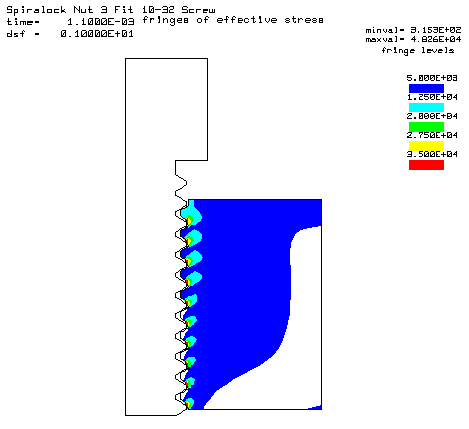 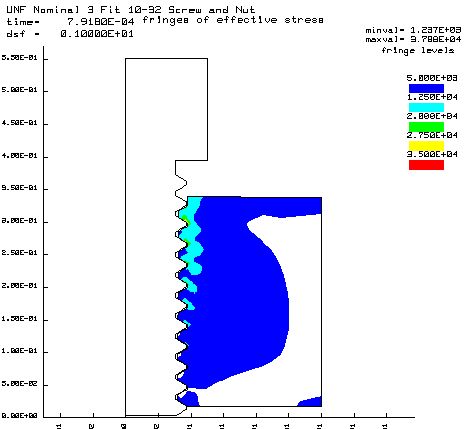 Good Hunting... from Varmint Al | |||
|
| One of Us |
Varmint Al, thanks for the great diagrams. Bill Leeper thanks for putting it into perspective. | |||
|
| one of us |
Wow, I posted this question and have not been back until now. I am absolutely amazed at the responses. Thanks for all the feedback. I respect all the effort and comments that each of you have contributed. I do, if not on an actual barrel to receiver, want anyway to play around with the thread form, and at the high cost of the inserts would rather grind my own lathe tool. The problem is that I am missing one essential dimension, the length of the 30 degree triangle's hypotenuse; the side that the 60 degree peak would seat on. Prior to posting, I had called Mr. Vaughn to discuss the drawing in his book, however he has suffered an impairment due to a severe medical event and was unable to discuss the matter. Beside his drawing on page 115, he states, "The width of the 30 degree ramp is 0.025 inch compared to the pitch or width of the thread of 0.0625 inch." Is the width of the ramp that he refers to the adjacent side of the triangle? If so, I can easily calculate the side that I need to make my tool. Many thanks, Theo | |||
|
| one of us |
There is one point of caution about the Spiralock thread form that I can think of. The design uses the very high radial load and yields the tips of the male thread. With a standard cap screw, nothing would change the radial loading. But with a rifle barrel, the pressure of the round being fired will cause a radial expansion of the male thread form. In another set of calculations where I was looking at chamber friction vs. brass stretching, I post processed the radial expansion of the OD of the barrel. 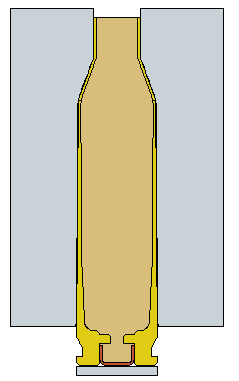 Here is a picture of the geometry. It was a 243 Win brass in a 416 Stainless steel barrel with an OD of 1.25". The study is located here: http://www.varmintal.net/a243z.htm The thread area at a 1.25" diameter will expand radially 0.00015" with a 50,000 psi chamber pressure inside the brass and this small amount of expansion and then contraction after the pressure is removed, will slightly relax the radial compression on the Spiralock thread form. I have not calculated the small amount of preload relaxation from the pressure loading. On the thread dimensions. It is proprietary information. However, the close-up view of the thread stresses is to scale and once you know the thread pitch the picture can be scaled. Good Hunting... from Varmint Al | |||
|
| one of us |
Varmint Al, In the case of a rifle barrel, with the thread form cut on the barrel, it is the tip of the female thread which would yield. In other words, the receiver threads. Now, if it is the receiver threads which yield then they are deformed and damaged. If the ramp cut on the barrel yields to the receiver thread (presumably harder)then it is the barrel thread which is deformed. This deformation takes place on the ramp. No big deal except for the risk of galling. Regards, Bill. | |||
|
| one of us |
[ 10-22-2003, 03:40: Message edited by: tigertate ] | |||
|
| one of us |
I was referring to the commercial diving industry, not scuba. Standards vary from company to company with some consensus within the industry association but not as uniform as the bubble blowers. Probably ought to leave it at that or move this over to politics. [ 10-22-2003, 03:38: Message edited by: tigertate ] | |||
|
| one of us |
First of all I am sorry to hear of Vaughn's health issues. He was a real gentleman, and wrote the best "Gun" book I have ever read. The reason he went to the thread was to prevent a barrel shooting wild from the lack of barrel thread preload. In the Remington rifles he was using the barrel actually is loose at max pressure. He proved that wild shots were the result of the barrel changing position in the receiver. Do you think that the threads on a "standard" aren't distorted when it is torqued in ?. Before people criticize they should at least try to understand the problem. Vaughns book gives the first rational explination of why bullets drift in the wind. No, it's not the wind blowing on the side of the bullet. Take Care! | |||
|
one of us |
quote:First off, NO they are not, providing that they are threaded properly. The torque should be applied to the shoulder. A properly threaded barrel when removed will unscrew just as easily as it was screwed together. Not to mention, it's been proven over and over again that a barrel fitted slightly more than hand tight, will shoot very well. While the Spiralock thread disperses the radial load over more threads, it actually reduces the amount of overall surface area that is making solid contact. This is why the threads will distort, and why that for overall shear strength, and the expansion and contraction factors of a barrel firing, it's an inferior product. But, as I posted earlier, it's really an exercise in futility. If anything catastrophic were to occur, the barrel is the last thing that's going to fail, regardless of the thread design, within in reason. If it's not the wind, what the hell is it? Just a little curious, considering I've sent more lead down range in high wind at extreme distances than the average shooter by a long shot(no pun intended) | |||
|
| one of us |
quote:I have not read Vaughn book yet. However I have been using the Spiralock thread form. If he says Spiralock will prevent wind drift I will reconsider buying his book. I don't have enough down range time with Spiralocked barrels to make a judgment. Greg Tannel has done several hundred this way and tells me that it eliminates double grouping. Makes since in that by spreading the load across all threads one has effected a more rigid barrel/receiver mating. I spent years in the prone position at 600 - 1000 yards. Exterior ballistics are just that. Mostly independent of actions before leaving the barrel. You could mill a one piece barrel/receiver and it is not going to effect wind drift. Rifle accuracy is the culmination of myriad details. Spiralock threads are not a cure all. Possibly, used correctly, they may provide one more aid in maximizing consistency. Wally | |||
|
| Moderator |
<listening for the sounds of the winds> winddrift is in my barrel and not the breeze down range? GMAFB sorry guys, it might be a snazzy way to spread load, but it's NOT going to stop physics. winddrift affects arrows, baseballs, freesbies, airplanes bullets and tall buildings (i work in one) Irv, I am certain you mean well, but stipulating that the threading of the barrel, within reason, has ANYTHING to do with winddrift is, well, hmmm, incredulous. IF it had anything to do with it, we would all be shooting sks's and rem 710s with their pressed in, 100% contact barrels jeffe [ 10-24-2003, 21:52: Message edited by: jeffeosso ] | |||
|
| <G.Malmborg> |
Ever watch a freight train ease forward from a sitting stop? The reason they don't "gun" the throttle (no pun intended), is to avoid breaking couplers. If you listen carefully you can hear each coupler take up slack as the load is increased. Once the slack is gone, full application of force can be applied without further worry as to the integrity of each joint. This same action could be compared to gun threads, if it were not for the fact that the threads (couplers), were already preloaded and set, by the torque placed upon the barrels shoulder and receiver face. As Matt pointed out, the load is applied to the shoulder. This would keeps the back side of the threads engaged with one another. If on the otherhand, as irv stated, that Vaughn had somehow proven that Remington barrels become "loose" at max pressure, and that "wild shots" were the result of the barrel changing position in the receiver, then I would think that reducing the slack through "better fitting" of standard threads would be enough to reduce any concern for "thread slap". Or maybe not... Regards, Malm | ||
|
| <KBGuns> |
This goes against everything I have learned so far to barrel fitting. In fact you do not even need tight threads, a slightly loose threads being prefearable. What you do need is a "square to the bore" barrel sholder and receiver face. A slighty loose thread will allow those two surfaces to true up to each other under torque, even if the receiver threads are not true to the bore or receiver face. You do not want to deform threads or tighten to near yeilding. Kristofer | ||
|
| one of us |
Man, oh man! Before jumping to some serious conclusions, let us take a look at what was actually written by Irv. "Vaughns book gives the first rational explination of why bullets drift in the wind. No, it's not the wind blowing on the side of the bullet." Where did he say that Vaughn explained wind drift by threading techinque? While I do not recall what part of the book he is referring to, my no means do I deduce from this quoted statement, that wind drift is caused by threads. I do appreciate all the discussion and the variety of opinion about the matter of barrel threading, however, I guess that I will have to, by trial and error, attempt to recreate the correct dimension that I need to make my tool. Do I recall correctly that in past years it was mandated by the government that there was no such thing as proprietary as long as it pertained to the making of guns? Perhaps I am dreaming. Regards, Theo | |||
|
| <G.Malmborg> |
Theo, What's the title of this book of Vaughn's? I have heard nothing to the contrary so I believe the term "proprietary" does include firearms... irv writes: "In the Remington rifles he was using the barrel actually is loose at max pressure. He proved that wild shots were the result of the barrel changing position in the receiver." and then he writes: "Vaughns book gives the first rational explination of why bullets drift in the wind." The discussion here is threads and thread forms, and this last sentence, by being injected into this discussion of threads, may have accidentally implied that perhaps the thread form, or, lack of thread "preload" was somehow responsible for this wind drift. It is probably a misunderstanding brought on by lumping all of this together in the post. Regards, Malm | ||
|
| one of us |
Wow! What I was saying was that Vaughn's book explains many "mysteries" involved with rifles. Threads and wild shots was one. Wind drift was another. The one poster may have made more long range shots than anyone alive, but he did not explain wind drift, Vaughn did. For those who will not read the book I will give a brief look. What has always bothewred me was "why does wind drift depend on the velocity lost ?". No one ever explained why, it just does. It must be taken on faith. Per Vaughn the stabilized bullet turns into the wind so that the angle of attack is zero (wind flowing straight back). Now there is a drag component that points down wind. The drag is a function of the BC which is defined as a "delay function". Thats why drift drift depends on the BC,and the "delay time". His discussion and measurements on barrel whip alone is worth the price of the book. I would recomend the book to anyone interested in why some things happen. The others will drown in their ignorance anyway. good luck! | |||
|
| one of us |
quote:Sounds like a good book Irv. However the study of ballistics didn't just now get a start. Many of us own, have read and studied James Virgil Howe's The Modern Gunsmith (1934). Many "mysteries" were well understood in 1934. Wally | |||
|
| one of us |
Has anyone ever checked the holding torque after a few shots are fired even with close fitting V threads like Harold did? In a rifle application he could not get the action barrel joint to stabilize. As far as the FEA is concerned that analysis does not appear to show deformation, or is it small. Whats the yield strength of the materials shown are the Youngs Modulus similar to a Stainless and Chromoly junction. Many barrel makers will tell you they have gotten barrels in that won't shoot and can't find anything wrong with them including proper thread fit. My point is a smith that is purchasing $200 plus tooling to thread a few barrels may be onto something. Many records are set with guns with loose bolts now we have fitted bolts does anyone still argue which is better? Without the instrumentation Harold used its going to be difficult to prove yeah or neah just by shooting for most mortals. Now I have a barrel that was reverse taper threaded as measured over pins the narrow part being closer to the action.The threads felt close fitting. Was this intentional or by mistake? | |||
|
one of us |
quote:I did not offer an answer to why the bullets are effected by wind, merely asking the question,"if it's not the wind, what the hell is it?" It is infact the wind blowing on the side of the bullet, but there are other factors that effect this as well. The same principal could be applied to an automobile driving through West Texas, God forbid. A small sports car will be less effected by the forces of a cross wind than a semi-tractor trailer, even though the tractor trailer weighs more, simply because it has more area that is in the path of the wind. But, this is only one minor example of a much larger problem. BC, twist rate, velocity, bullet weight, and bullet geometry all fall in there as well. So as we don't get these two totally different topics confused, I will use mucho spaces. In terms of barrel threads and threading in general, more often than not, the average gunsmith does not have the tools necessary to properly check or make a thread of high enough quality to fully test these theories. Not to say that the threading is inadequate for it's purpose, but for extremely accurate threads, it requires a great deal of skill in tool grinding as well as inspection and actual threading to achieve threads that could actually be tested accurately without introducing other factors into the equation. An insert will not necessarily cure this problem. Case in point: DemoSam's barrel is threaded with taper. Probably not intentional. If it was, I could not see a reason for it, but then again, who knows. More than likely what happened was that the barrel was hanging too far out of the chuck, or worse yet, the steady rest. When this happened, it caused excessive tool deflection on the end of the barrel. As the tool drew closer to the end of it's cut, it aquired less deflection, causing it to cut smaller. All of this is based on the fact that his machine was setup accurately enough to produce a straight thread with all other factors being equal. But, more than likely, you're looking at the result of some tool deflection. | |||
|
| one of us |
Trigger Guard: If bullet drift was due to the wind blowing against the side of the bullet the drift would vary as the time of flight. It dosen't. The reverse taper threads are another approach to getting even thread contact. Varmet Al; You could be the guy to answer a question I have had for a while. When a barrel is screwed into the receiver it's shank is in tension, and the receiver is in compression. That is why only a few threads are tight. In a mauser 98 the barrel presses against the internal collar. This would put the shank in compression. My question; Will making the barrel butt against both surfaces ( as some old timers advised) lload the threads evenly?. Take Care! | |||
|
| one of us |
quote:What then, Irv, requires a rifleman, to change his windage dope when moving from 300 yard line to 600 yard line? Wally | |||
|
| one of us |
The barrel had a reverse taper of about .006" on the diameter so the tool deflection would be .003". It seemed excessive for just tool deflection but who knows whats going on. This barrel came from a MT based smith. It scattered shots quite readily. | |||
|
| <G.Malmborg> |
irv, I would have to agree with Matt. The reverse taper would have to be the result of tool deflection. Tool deflection becomes more prominent the further the material is from the support or the jaws. This lack of support allow the material to be pushed out of the way by the tool resulting in precisely that, a reverse taper. You cannot increase thread contact when only one part of the joint is tapered. Malm | ||
|
one of us |
quote:I'm not trying to be argumentative here, but what you're telling me goes against everything that I've ever seen, heard, read, experienced, or imagined. So, to sum this up briefly, if the wind is blowing east to west at 10mph, and I'm shooting in a due north direction, the bullet will not be moved from it's aimed point to the left of the bullseye?? I keep a pretty open mind about most everything that I run across, but holy crap batman, what are you smoking? Tell me that I'm completely reading your comments wrong, and that I've misinterpreted your posts. You do mean something else right | |||
|
| Powered by Social Strata | Page 1 2 |
| Please Wait. Your request is being processed... |
|
 The Accurate Reloading Forums
The Accurate Reloading Forums  THE ACCURATE RELOADING.COM FORUMS
THE ACCURATE RELOADING.COM FORUMS  Guns, Politics, Gunsmithing & Reloading
Guns, Politics, Gunsmithing & Reloading  Gunsmithing
Gunsmithing  Spiralock threading for barrels
Spiralock threading for barrels

Visit our on-line store for AR Memorabilia

